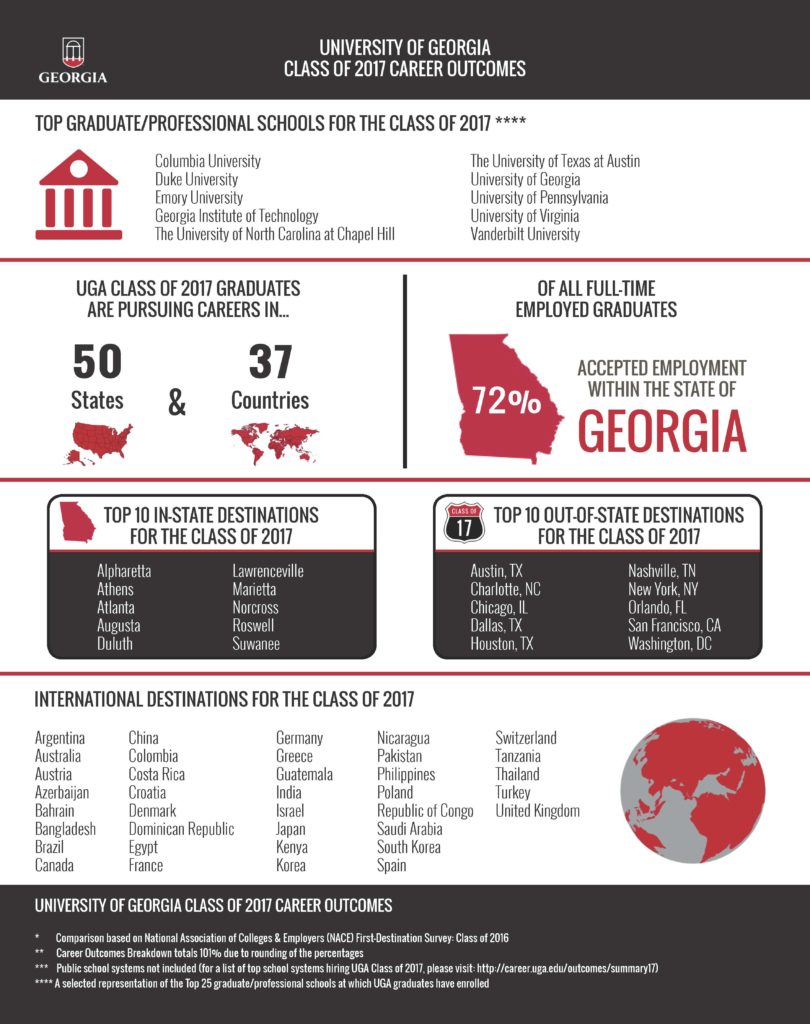University of Georgia research shows that 96 percent of recent graduates are employed or continuing their education within six months of graduating. UGA’s career outcomes rate for the Class of 2017 is 11 percent higher than the national average.
Of those students:
• 63 percent were employed full time;
• 20 percent were attending graduate school; and
• Approximately 12 percent were self-employed, interning full time or were employed part time.
“UGA’s high career outcomes rate demonstrates our university’s commitment to providing students with opportunities to learn in and beyond the classroom,” said Scott Williams, executive director of the Career Center. “Combined with our strong academics, the experiential learning requirement provides students with hands-on experiences, such as internships, equipping them with the skills and experiences that make them more competitive in the job market.”
The UGA Class of 2017 was hired by 2,925 unique employers, including Fortune 500 companies, across all 50 states and in 37 countries. Of the full-time employed graduates, 72 percent accepted employment within Georgia. Top employers for the Class of 2017 include AT&T, Chick-fil-A, IBM, Georgia-Pacific and UPS.
“Our state benefits from being home to so many successful companies—companies that want to hire our students,” said Jill Walton, UGA’s executive director of corporate and foundation relations. “UGA is committed to serving our state through educating tomorrow’s leaders.”
These graduates are working in all sectors of the economy—66 percent in business, 24 percent in education, 6 percent in government and 4 percent in nonprofits.
“UGA students are pursuing careers in diverse industries, career areas and geographic locations,” Williams said. “We are proud that our students continue to secure positions with top companies, as well as enter highly selective graduate and professional programs.”
The 20 percent of graduates who are continuing their education are attending top graduate schools such as Columbia University, Duke University, Emory University, Georgia Institute of Technology and the University of North Carolina at Chapel Hill.
The career outcomes rate is the percentage of students who are employed, continuing their education or not seeking employment within six months after graduation. The UGA Career Center calculates the career outcomes rate each January by leveraging information from a variety of sources. This year, the Career Center was able to collect data on 88 percent of 2017 graduates, 26 percent higher than the national average, which helps provide a more accurate snapshot of UGA students’ employment status. Outcomes data was collected using the following sources: survey, phone calls, employer reporting, departmental collaboration, LinkedIn and the National Student Clearinghouse.
More details about UGA’s Class of 2017 career outcomes, is online.
More about hiring UGA graduates is online.
UGA Career Center
The University of Georgia Career Center provides a range of services, helping students identify potential careers, connecting them with employers for job interviews and internships and much more. The Career Center’s home, Clark Howell Hall, provides spaces for career advising, networking events and job interviews.









